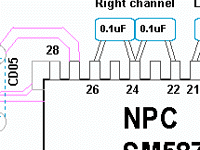
Click the image left for diagrams showing the modification.
Inveterate meddling #101, part 2: playing inside the Marantz CD63 some more
Not content with the previous invasive surgery on an old CD63SE here are a few more things for you to try. Who said 'never leave well-enough alone' ?

|
Recipe: Click the image left for diagrams showing the modification. |
The object this time is to get obsessive about power bypassing.
The SM5872B dac is rather well laid out, in that there are separate power supply pins for each section of the chip: the clock logic gate, the Delta-sigma converter, and four for the analogue output stage. These last four decouple the +5V supplied via link U200 we replaced with a new, low noise, 5V regulator on the previous page -we cannot recommend this modification too highly.
Note that the analogue stage on this chip is not an inbuilt opamp which limits the sonic potential of the chip, as with so many recent 'bitstream' converters; rather, it is a buffer stage which outputs a quasicomplimentary PWM stream unfiltered from the converter stage. Whilst this is arguably the reason this DAC can sound so damn good, it presents a major problem: there is much RF present on the audio output, and so adequate bypassing must be provided to suppress interference and provide a low impedance supply far, far above the audio passband. The way to suppress intereference effects is to keep the current loops as small as possible - decoupling right at the DAC pins.
Pin 15 is the digital supply 0V connection, connected to the ground plane; the Ov connections for the left and right analoge stages are interleaved with the relevant supply pins.
Note from the datasheet, the digital section typically draws 35mA, the analogue stage 1-2mA and the clock gates 3mA. This suggests that:
Our new capacitors are fitted directly across pins shown in the diagram, as tight to the chip as possible; ceramic capacitors are the best option due to their electrical properties and their tiny size; the critical thing is keeping the lead lengths as short as possible. As with the clock mod the best way to achieve this is to pre-bend the leads until the cap just fits across the DAC pins, and clip them until the new capacitor sits tight against the chip - when the board is reinstalled, you'll only have about 1/4" clearance from the case for this cap to fit into! Pre-tin the cap leads with solder off board, then holding the cap in place with tweezers (or blutac), when you're sure you're in the right place, momentarily touch the cap leads with your soldering iron and the cap will be soldered in place.
We also replaced CD15 & 16 (electrolytic) with two of the 220uf Elna Silmics removed from the output, because they were to hand. It's not an essential modification at all - with the new ceramics we've just added they should be doing very little.
the payoff
These modification is in the 'probably worthwhile' category ; the effect is subtle and seems to be related to better differentiation of instrument textures. Anyway it made us feel better, so don't overlook the placebo effect...
Of course, not stopping here for long, this CD63 now looks like this ... © the twisted pair 2002